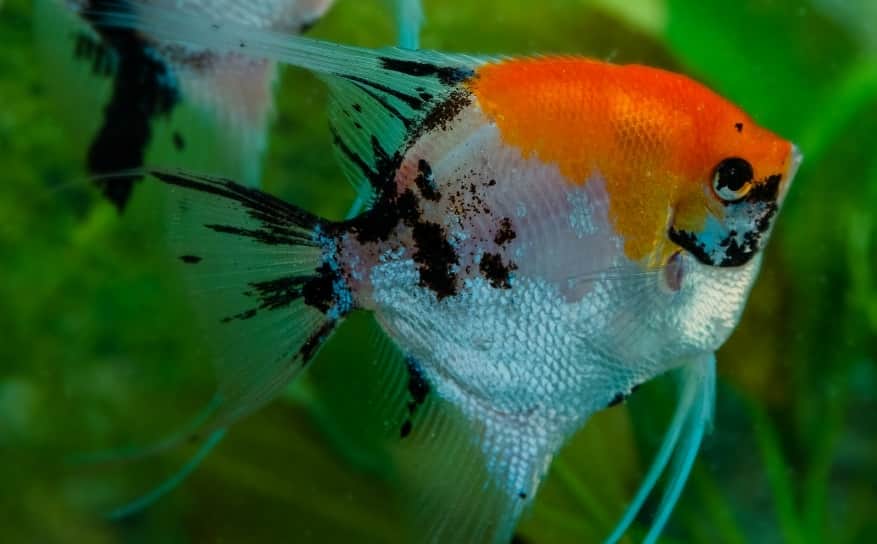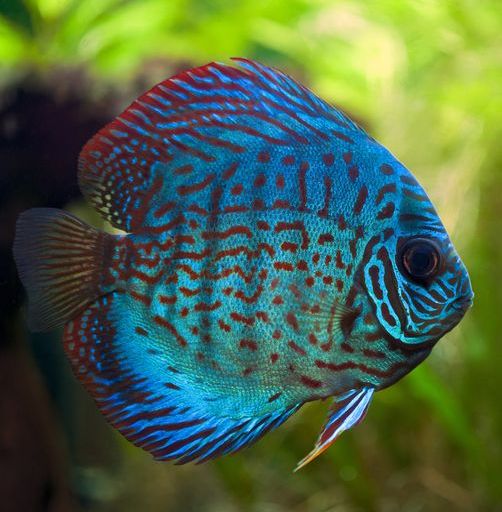Tiger Barbs: Because Your Aquarium Wasn’t Chaotic Enough…

Above: Tiger Barbs in the Authors 75 Gallon aquarium
I’ve kept Tiger Barbs for about 2 years. Right now I have 10 highly colored Tiger Barbs and 5 or 6 Zebra Danios in my 75 gallon aquarium. You can see my set up in the picture at the top of this page.
The Tiger Barb: Beyond the Stripes…
I know from experience that Tiger Barbs are extremely active. The chase each other in a bid for dominance in the group. Because they breed in the 75 gallon aquarium the males chase the larger, fat females as part of the group dynamics.
At this point I can say that Tiger Barbs are an easy fish for just about any hobbyist with a few small caveats.
The Tiger Barb (Puntigrus tetrazona) grows to about 2.5 inches (6.3 cm) They very active and do have a tendency to pick on each other so it’s not a bad idea to have a spacious aquarium.
With the correct tankmates they do make a good community fish. The Tiger Barb school activity will make the community tank more exciting.
If you’ve purchased a Tiger Barb school I can share with you a little information about your new fish.

Experience These Article in Audio Using Your Browser!
If a system or browser is not mentioned here, the I haven't been able to find out how to make the system or browser work to read aloud.
PC's: Using the Edge Browser, left click on the article text and scroll down to "Read Aloud." The article will automatically be read to you.
iPhone using the Edge Browser: Using the Edge brower, tap the icon that looks like a book with a speaker located in the in the address bar. The article will come up now showing 4 icons on top. Tap on the second icon from the right to have the article read to you.
Android phones: Google Assistant is the most convenient way. Say, "Google, read this page."
How big do Tiger Barbs get? What colors do Tiger Barb fish come in?
Adults are usually 2.30 inches (6 cm) long but can reach up to 3 inches (8 cm), making them the perfect size for just about any community tank or a species-specific tank.
Regular Tiger Barb Colors include silver or somewhat brownish with four vertical stripes and a hint of red on the the tail, fins, and snout.

How Long Do Tiger Barbs Live? Life Span
A healthy Tiger Barb can live in captivity for 5 to 10 years, with the most common being around six years.
Video #1: Tap image to view video in a new tab or window.
Tiger Barbs and a guppy in my 30 gallon. At this time the barbs were pretty young. They are about twice this size now.
What should you feed your Tiger Barbs?
Tiger Barbs are an omnivorous fish, meaning they eat protein and vegetable-based foods.
In nature, what they are said to eat includes worms, crustaceans, insects, and insect larvae. On this site: How to grow your own live fish foods – 8 easy types.
I feed my Tiger Barbs twice a day. They receive insect larvae, frozen brine shrimp, frozen bloodworms, and decapsulated brine shrimp eggs.
Side Note: My Tiger Barbs love Ramshorn Snails. I buy these by the hundred on eBay and keep them in their own tank. The Barbs get about three a day in the morning.
I feed my Tiger Barbs twice a day. They receive insect larvae, frozen brine shrimp, frozen bloodworms, and decapsulated brine shrimp eggs.
They are big, happy Tiger Barbs that occasionally breed in the community tank. This shows that they are being fed correctly.
Image above Tiger Barbs and a male platy in my aquarium
How Do Tiger Barbs Behave In An Aquarium? Tiger Barb Behavior
When kept in a large enough school (I’m going to say at least 8 or 9. More is better.), Tiger Barbs are extremely active.
They aren’t shy but still need to dart to a hiding spot if startled. They will come out from hiding fairly quickly.
Tiger Barbs are mid-level feeders in the aquarium, although they will occasionally grab food from the top of the water. When feeding, they are very active. You can see this in video #2 on this page.
Although I haven’t noticed it, the species has a loose hierarchy system, with rival males continually vying for status within the group. To disperse aggression, keep a group of at least ten individuals minimum, in your aquarium.
Keeping fish can be costly, but there's a great way to offset those expenses.
Consider creating your own income producing website, just like I did with this one! I advertise Divi website creator, but you could place other ads on your website.
I've used Divi Wordpress website builder to build this site, and it's incredibly user-friendly. With its drag-and-drop interface, creating your own website becomes a breeze.
Simply tap this box to get started and see how easy it is to create a website with Divi.
The cost is $89/year. This is $7.41 per month. Divi comes with a 30 money-back guarantee. Try it at no risk.
Take this box to visit the Divi website to learn more. The link opens in a new window.

* Great Video: How to make a Website | Divi Tutorial 2024
A group of Tiger Barbs (and spinach) in my 30 gallon.
(Upper left: “Do I look fat in this Tiger Barb outfit?”)
Click here to see and download a full size copy of this picture.
Opens in a new tab. If you use this picture on your site make sure to link back to this page.
How agressive are Tiger Barbs?
An aggressive Tiger Barb will display by spreading its fins, chase after and nip at other Tiger Barbs. An unusually bright display of their colors is a warning of their agressive intent.
In this species of barb, males will always disturb the females and fight other males for higher positions within the group.
Regardless of the size of the aquarium, disputes will occur. Tanks with higher volumes will give more areas to escape and hide for fish on the receiving end of such aggression.
While you don’t want to have less than 10 Tiger Barbs in an aquarium, you also want to take care not to overcrowd.
What fish can I keep with Tiger Barbs?
Here are a few fish that would work well with Tiger Barbs:
1. Zebra Danio
2. Harlequin Rasbora
3. White Cloud Minnow
4. Galaxy Rasbora
5. Sparkling Gourami
6. Corydoras (Cory Catfish)
7. Bristlenose Plecostomus
8. Royal Plecostomus
9. Rummy Nose Tetra
10. Cherry Barb
The Tiger Barb is a fish known to sometimes be aggressive towards its tank mates, so it may not always be the ideal companion. It can, however, get along very well in a community aquarium that contains other fast-swimming fish.
We know Tiger Barbs as “fin-nibblers”. When maintained correctly, with all requirements fulfilled, they are actually a peaceful fish with other fish species.
Whenever you keep Tiger Barbs in a community tank, choose similarly sized tankmates. My 75 gallon aquarium has 10 Tiger Barbs, 1 bright orange molly fish, and 7 Zebra Danios. So far, the Tiger Barbs have not disturbed the other fish. When in groups, the Tiger Barbs annoy and chase each other rather than the other aquarium inhabitants.
Avoid placing this species long-finned slower moving fish.
What’s the best fish to place with the Tiger Barbs? Even more Tiger Barbs! Imagine a 100 gallon aquarium filled with driftwood, rocks, large sword plants, and 40 Tiger Barbs, with no other fish.
Finally, don’t forget that the Tiger Barb, as a schooling fish, needs to live in the company of others of its kind. When you buy Tiger Barbs for your home aquarium, you will want to buy at least 10 Barbs.
The 20 Easiest Freshwater Aquarium Fish for Beginners


Infographics – 10 fish to keep with Tiger Barbs



Image above: Female Tiger Barb in the authors aquarium
Tiger Barbs in my aquarium.
Click picture to view full size or use on your site (link back to this page please)
Picture #6 – Tap picture to view full size. Top fin was nipped, probably during a scuffle.
How Do I Set Up A Tiger Barb Tank?
Being an incredibly active fish that likes to swim almost frantically, you must provide them with plenty of space. I recommend an aquarium of 55-gallons (150 liters) or more.
To provide a suitable aquarium for barbs, make sure that the physical and chemical parameters of the aquarium water are correct to support the species.
Tiger Barb aquarium maintenance is not dependent on aquarium decorations. Still, plants, driftwood, and rocks help replicate the conditions in nature and serve as a hiding places during disputes and fights.
The ideal tank temperature will be between 74º F and 80º F (23º C and 27º C). Water hardness level of up to 10 dGH and a pH between 5 and 7.6. This means soft water is best, if possible. They are flexible about water hardness. I know this because I have kept healthy barbs in very hard tapwater.
How Do You Tell The Difference Between Male And Female Tiger Barbs?
The male is slightly smaller, thinner, and has a more intense color pattern than females. This is especially noticeable on their snouts and tips of the fins. Mature alpha males and quarrelsome males have intense body coloration. Females have a mouth the same color as the rest of the body and are thicker.
The Tiger Barb is a simple fish to breed
It is an egg-scattering, free spawning species whose reproduction process is like other barbs.
I actually see my Tiger Barbs spawning in the community tank, so getting them to lay eggs is fairly easy.
When the species reaches the size of about 1.5 inches (2 to 3 cm), they become sexually mature (9 months or more). The mating ritual begins with the male displaying himself to the female, who, if interested, will disperse the eggs freely along the substrate. The male will then fertilize the eggs.
The parents do not exhibit parental care and will eat all eggs and fry if given a chance.
When breeding Tiger Barbs, make the aquarium bottom inaccessible to the breeding pair or remove them after they are done.
Ideally, set up a breeding tank of about 20 gallons / 75 liters, with a filter, heater, some plants, and a spawning crate or marbles covering the bottom on the aquarium . If possible put two females and one male in the breeding tank.
First, place the female in the breeding tank, and after a few days, add the male when she is full of eggs (pregnant females will have a considerably larger rounded belly and a darker, almost black dorsal fin).
The courtship ritual starts in the late afternoon, with them swimming around each other most of the time.
Spawning usually occurs in the morning, with the male chasing and nipping the female. The female will release between 1 and 3 eggs at a time. Most mature females can release around 300 or more eggs. The males will follow closely behind to fertilize them all.
The fry will hatch within 48 hours and swim freely within one day more. Feed the fry infusoria, liquid food for fry, and brine shrimp nauplii, at least three times a day. Remember that fry need high-quality water to survive.
For more information on breeding Tiger Barbs, see this excellent publication (opens in a new tab): http://www.ctsa.org/files/publications/CTSA_1296316728612942177442.pdf
Tap here to return to the table of contents
Where do Tiger Barbs come from?
This species of Barb is native to Sumatra, an island in Indonesia. In addition, researchers also found these barbs in the waters of Borneo, an island in Southeast Asia.
As much as the fish has been in the hobby for many years, its authentic biotope and area of occurrence are still slightly unknown or unconfirmed. We believe the population we see in aquariums today to come from central and southern Sumatra. Researchers have recorded the species in Borneo, with additional records in the Indragiri, Batang Hari, and Musi river systems in Riau, Jambi, and South Sumatra provinces.
https://maps.app.goo.gl/zhQnkQvtCgEHUYSTA
In nature, the species usually inhabit streams and ponds, channels, and ditches. The substrate of the sites are usually sand and rocks.
We usually find this species amid dense aquatic vegetation and always in large schools. This increases their protection from predators like large fish and birds.
Tap here to return to the table of contents
What Are Common Tiger Barb Diseases?
Tiger Barbs are a very disease resistant species. There are no specific diseases that affect only this species, but they are susceptible to low water quality.
Unfortunately, many fish traded today are genetically weak, prone to disease, or develop physical deformities because of excessive inbreeding. This goes for Tiger Barbs too.
As with any other fish, the best advice we can give is to make sure your water condition is as close to perfect as possible, and you shouldn’t have too many problems. Good filtration is always a good place to start.
Table of Contents
Picture 7 – “I just hate rush hour.” Tap the picture to see the original, large picture. This picture can be used on your site just link back to this page if you borrow this picture.
Tiger Barb FAQ
Question: “Are Tiger Barbs easy to keep?”
Answer: Tiger Barbs are very easy to keep. They are disease resistant and can take some neglect.
Question: “How many Tiger Barbs should be kept together?”
Answer: “The more, the merrier.” This is fish that likes to school with its own kind. I have five in my tank. Eight is better. More than eight is heaven for Tiger Barbs.
Questions “How often should you feed Tiger Barbs?”
Answer: At least twice a day. I feed mine smaller amounts 3 or 4 times per day.
Question: “Can Tiger Barbs be kept with Goldfish?”
Nope. Don’t even go there.
-
- Goldfish are not a tropical fish. To live they need basement cool temperatures (65º F) or less. Tiger Barbs should be kept at 75º F to 80º F.
- Tiger Barbs would consider the fins of the slower moving Goldfish as a snack. They would nip, bite and eat the Goldfish’s fins.
Question: “What are the best Tiger Barb tank mates?”
Answer: Any active species of tropical fish with “non-showy” fins would work. For example: female guppies and other live bearers, Danios, other Barb fish, Plecos, Corydoras, and Tetras.
Tap here to return to the table of contents
Tiger Barb Facts Sheet
Common name: Tiger Barb, Sumatra Barb
Order: Cyprinodontiformes — Family: Cyprinidae
Distribution: Asia, found in Sumatra and Borneo. Widely introduced and established in many countries.
Behavior: Semi-aggressive, communal
Adult Size: 8 cm (common: 6 cm)
Life Expectancy: 5 years
pH: 5.0 to 8.0
Hardness: 5 to 19
Temperature: 74º F to 80º F
Minimum aquarium: 30 gallons
Feeding: Omnivorous – will readily accept dry and live food.
Reproduction: Oviparous (egg laying)
References.
Bundesministerium für Ernährung, Landwirtschaft und Forsten (BMELF), 1999. Gutachten über Mindestanforderungen an die Haltung von Zierfischen (Süßwasser). Bundesministerium für Ernährung, Landwirtschaft und Forsten (BMELF), Bonn, Germany. 16 p.
Mills, D. and G. Vevers, 1989. The Tetra encyclopedia of freshwater tropical aquarium fishes. Tetra Press, New Jersey. 208 p.
Tan, H.H., 2012. Systomus navjotsodhii, a new cyprinid fish from Central Kalimantan, Borneo. The Raffles Bulletin of Zoology, Supplement No. 25:285-289.
Welcomme, R.L., 1988. International introductions of inland aquatic species. FAO Fish. Tech. Pap. 294. 318 p.
Tap here to return to the table of contents
How To Take Aquarium Photos


Other pages on this site:
* Freshwater Aquarium Plants You Can Grow
* 11 Exquisite, Effortless Aquarium Plants That Totally Won't Outgrow Your Tiny Fish Tank
* Discus Fish: Because Regular Fish Just Aren't Enough of a Challenge
* Planted Nano Aquarium Magic: Tricking Your Plants Into Thinking They're Happy (CO2-Free Method)
* How to Train Your Oscars: Because Fish Totally Respond to Commands Like Dogs
* What size aquarium should you get?
Introducing: The Most Relaxing Hobby Ever! (Just Kidding, It's a 24/7 Drama)
How to grow a stunning, small planted Aquarium.


How To Care For, Feed, And Make A Sandwich Out Of Your Adorable Goldfish








